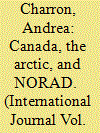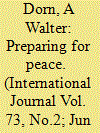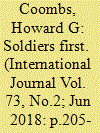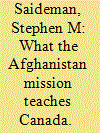|
|
|
Sort Order |
|
|
|
Items / Page
|
|
|
|
|
|
|
| Srl | Item |
| 1 |
ID:
138286


|
|
|
|
|
| Summary/Abstract |
The Arctic is perceived as an area that requires increased North American Aerospace Defense Command (NORAD) attention. On the one hand, the region has always been of particular concern to NORAD, especially during the Cold War. From this perspective, attention to the Arctic is business as usual. On the other hand, increased potential traffic in the region due to warmer temperatures, natural resource exploitation, and tourism could increase threats to North America and create the need for a new NORAD posture. This paper reviews the challenges facing the Arctic, the perceived new urgency for attention, the command and control structures of NORAD, and NORAD’s specific preoccupations in order to answer the question: does the Arctic represent status quo for NORAD or does NORAD need to change, fundamentally, its approach to the North? This paper ultimately argues for the former.
|
|
|
|
|
|
|
|
|
|
|
|
|
|
|
|
| 2 |
ID:
178329


|
|
|
|
|
| Summary/Abstract |
A “connected battlespace” (CB) aims to leverage emerging technologies, such as low Earth orbit satellites, internet of things devices, cloud computing, and artificial intelligence, in order to collect, process, and disseminate large quantities of data in real time, thereby providing decision-makers with the ability to respond to threats faster and with more precision. Despite its promise, as a concept, a CB is still misunderstood, underdeveloped, and understudied. In an effort to fill this gap, this policy brief describes several key findings derived from an expert stakeholder workshop that the authors convened in July 2020. Workshop participants probed several questions about the development of Canada’s CB infrastructure, touching on a number of themes, including alliance partnerships, emerging technology, procurement, national security, and defence strategy. Our article synthesizes and analyzes key discussions held during this workshop.
|
|
|
|
|
|
|
|
|
|
|
|
|
|
|
|
| 3 |
ID:
188904


|
|
|
|
|
| Summary/Abstract |
The Synthetic Environment (SE) takes the power of computing, digital processing, artificial intelligence, extended reality technology, and other advancements borrowed from the gaming industry to create a computer simulation with near-perfect levels of realism. Designed to enable connectivity across all domains and platforms, SE has the potential to dramatically improve military training, force development, situational awareness, and communications. Our article provides a technical overview of SE and offers a high-level analysis of its use in Canada, the US, UK, and Australia. Informed by dozens of interviews and a roundtable workshop held with experts from academia, industry, and government, this article relates SE to Canada’s future defence policy. We argue that leveraging SE effectively will require that Canada commit to a long-term SE program, promote new government-industry partnerships, encourage top-down leadership from both civilian and military officials, and consolidate domestic skillsets and industry knowhow to maintain and retain Canadian sovereignty.
|
|
|
|
|
|
|
|
|
|
|
|
|
|
|
|
| 4 |
ID:
188914


|
|
|
|
|
| Summary/Abstract |
The Synthetic Environment (SE) takes the power of computing, digital processing, artificial intelligence, extended reality technology, and other advancements borrowed from the gaming industry to create a computer simulation with near-perfect levels of realism. Designed to enable connectivity across all domains and platforms, SE has the potential to dramatically improve military training, force development, situational awareness, and communications. Our article provides a technical overview of SE and offers a high-level analysis of its use in Canada, the US, UK, and Australia. Informed by dozens of interviews and a roundtable workshop held with experts from academia, industry, and government, this article relates SE to Canada’s future defence policy. We argue that leveraging SE effectively will require that Canada commit to a long-term SE program, promote new government-industry partnerships, encourage top-down leadership from both civilian and military officials, and consolidate domestic skillsets and industry knowhow to maintain and retain Canadian sovereignty.
|
|
|
|
|
|
|
|
|
|
|
|
|
|
|
|
| 5 |
ID:
157679


|
|
|
|
|
| Summary/Abstract |
Pioneering feminist International Relations scholarship suggests that in order to function, militaries rely on spouses, most often wives, to undertake the majority of domestic labour, suspend their own careers, and relocate willingly for new postings. However, the contemporary military family’s relationship to war making may be different because family forms are changing: norms around domestic responsibilities and primary earners suggest greater gender equality, and women are contributing to war making as soldiers. Thus, this paper asks whether the military’s reliance on the traditional family, and conventional gender relations, is being reinforced or destabilized by policies and programs that speak to Canadian military families. A critical feminist policy analysis of select policy and program documents, which address unique and characteristics of military life (mobility and separation) is undertaken. While there is discursive acknowledgment of the changing composition of military families, traditional familial and gendered assumptions persist in subtle ways.
|
|
|
|
|
|
|
|
|
|
|
|
|
|
|
|
| 6 |
ID:
160802


|
|
|
|
|
| Summary/Abstract |
During the Harper years (2006–2015), Canada significantly reduced the training, preparation, and deployment of military personnel for United Nations (UN) peacekeeping. Now, despite the Trudeau government’s pledge to lead an international peacekeeping training effort, Canada’s capabilities have increased only marginally. A survey of the curricula in the country’s training institutions shows that the military provides less than a quarter of the peacekeeping training activities that it provided in 2005. The primary cause of these reductions was the central focus on the North Atlantic Treaty Organization’s Afghanistan operation and several lingering myths about peacekeeping, common to many Western militaries. As the Trudeau government has committed to reengaging Canada in UN operations, these misperceptions must be addressed, and a renewed training and education initiative is necessary. This paper describes the challenges of modern peace operations, addresses the limiting myths surrounding peacekeeping training, and makes recommendations so that military personnel in Canada and other nations can once again be prepared for peace.
|
|
|
|
|
|
|
|
|
|
|
|
|
|
|
|
| 7 |
ID:
160798


|
|
|
|
|
| Summary/Abstract |
The Canadian Army has historically adopted a paradigm of preparing for peace operations by training and educating both soldiers and leaders to be capable of general-purpose combat. This paradigm of “soldiers first” has not been without its flaws, particularly when the security environment, the operational mandate, and mission preparation became unaligned. Consequently, as we move forward into the peace activities of the twenty-first century, where Canadian soldiers will be committed to operations in complex regions like Africa and the Middle East, it will be necessary to identify and institutionalize the lessons of the past in order to ensure that the model of “soldiers first” can be adapted to the varied challenges of the contemporary and future security environment through a holistic application of specialized training, leader education, and institutional support.
|
|
|
|
|
|
|
|
|
|
|
|
|
|
|
|
| 8 |
ID:
185229


|
|
|
|
|
| Summary/Abstract |
A connected battlespace aims to enable seamless, real-time connectivity between various military assets across all domains of contemporary warfare. Such a program, however, cannot be accomplished without the use of space-based assets that are designed to store and transmit data; enable communications, surveillance, and imagery; and bolster interoperability between different military forces and services. Given recent technological advancements, coupled with international interest and the diminishing cost of launching satellites into low Earth orbit, this article explores the opportunities and drawbacks associated with the Canadian Armed Forces’ embrace of novel space-based technologies. Following dozens of consultations and a stakeholder workshop held with academic, industry and policy experts, we argue that developing, procuring, and exploiting these capabilities is essential for Canada’s future force development, augmenting situational awareness in a pan-domain environment, and retaining a degree of sovereignty in an era marked by disruptive technologies, strategic uncertainty and great power competition.
|
|
|
|
|
|
|
|
|
|
|
|
|
|
|
|
| 9 |
ID:
152504


|
|
|
|
|
| Summary/Abstract |
This paper considers some of the lessons that can be drawn from Canada’s experience in Afghanistan. It focuses not just on the military but also on the rest of the government, two prime ministers, the opposition, the media, and the public. While the primary lesson might be “do not do this kind of thing again,” there are other lessons to draw that apply to Canada’s foreign and defence policies every day.
|
|
|
|
|
|
|
|
|
|
|
|
|
|
|
|
|
|
|
|
|